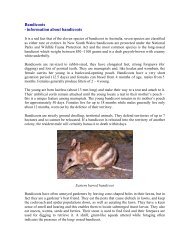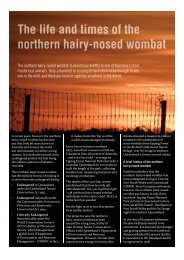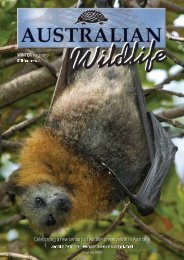Wildlife Preservation Autumn 2012.indd - Wildlife Protection Society ...
Wildlife Preservation Autumn 2012.indd - Wildlife Protection Society ...
Wildlife Preservation Autumn 2012.indd - Wildlife Protection Society ...
Create successful ePaper yourself
Turn your PDF publications into a flip-book with our unique Google optimized e-Paper software.
Pouch life<br />
The female echidna lays a single,<br />
leathery egg the size of a grape every<br />
breeding cycle and their breeding<br />
cycle is individualistic – it can be as<br />
infrequent as once every ve years,<br />
while a male echidna can be sexually<br />
active each year. The mother echidna<br />
then rolls the newly laid egg into a<br />
deep pocket or pouch located on her<br />
belly to keep the egg safe, which is<br />
then incubated. The pocket or pouch<br />
is really more like a fold of skin over<br />
the abdomen area which is closed with<br />
contracting muscles.<br />
The newborn is called a puggle, it is<br />
hatched around ten to eleven days<br />
later and is less than 1.3 centrimetres<br />
long and around 0.3 of a gram, smaller<br />
than the size of a jellybean! Luckily<br />
for the mother the puggle is not born<br />
with spines, instead it is a tiny mass<br />
of pink esh. The puggle uses its tiny,<br />
see-through claws to grip the special<br />
hairs within the mother’s pouch. The<br />
mother does not have nipples the<br />
way other mammals do. Instead, the<br />
little puggle will suck at milk that is<br />
excreted from special glands on the<br />
skin in the mother’s pouch. The puggle<br />
is carried in the pouch for about 53<br />
days when its spines begin to break<br />
through. At this stage the mother<br />
leaves it in a nursery burrow and the<br />
puggle is left alone. The mother blocks<br />
up the entrance to the burrow to stop<br />
the puggle crawling out. Temperature<br />
in the burrow is 15–21°C. The mother<br />
returns every ve to six days and feeds<br />
40 percent of the baby’s bodyweight<br />
in one feed, so a new baby in care may<br />
not need feeding immediately. All<br />
echidnas, and especially immature<br />
puggles, su er heat stress and overheat<br />
rapidly, so they should be kept in a<br />
semi-torpid state.<br />
The young echidna leaves the burrow<br />
at around six to seven months of age,<br />
weighing approximately one to two<br />
kilograms and is weaned approximately<br />
four weeks later.<br />
If you see an echidna and it is not<br />
injured or in danger, then leave it<br />
alone. Remember: echidnas are a<br />
protected species in all states and<br />
territories. If the echidna is in danger,<br />
ie on a road or being threatened<br />
by a predator, move it away. Only<br />
authorised wildlife carers or<br />
researchers with permits are allowed<br />
to pick up an echidna for transport or<br />
rescue.<br />
Australian <strong>Wildlife</strong> Vol 2 - <strong>Autumn</strong> 2012<br />
An echidna skeleton. This skeleton was most likely put together in a museum, the tibia and foot of the<br />
hind leg are rotated in the incorrect position (thanks to Peggy Rismiller for seeing this). Photo credit<br />
Wikipedia<br />
Echidna baby just born from the egg. Pink, blind<br />
and totally reliant on its mother<br />
Puggle echidna. Photo: Helen Taylor<br />
Credit: www.arkive.org Credit: www.arkive.org<br />
Echidna egg the size of a grape<br />
39





